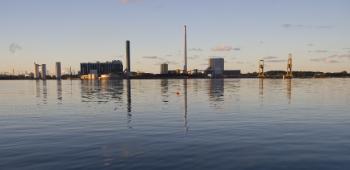Recommendation 12
Planning and design of infrastructure should consider the material and resource demands of infrastructure pipelines to identify opportunities for reducing waste in the construction and operation phases,whilst designing for end of life material recovery or repurposing of infrastructure.
Infrastructure requires significant volumes of materials for its construction, maintenance and operation. The physical scale of infrastructure often requires quantities of raw materials that outweigh many other industrial demands, and their extraction has environmental, economic and ultimately social costs. The UK’s National Infrastructure Plan[63] and plans for increased low-carbon technologies[64] will place increased demands on indigenous materials (e.g. bulk construction materials), and those imported from foreign markets (including rare earth metals). These demands are not unique to the UK and yet the commodities are finite. iBUILD research has shown how movements of such resources are already subject to short-term disruptions.[65*]
Over longer timeframes, planning and design of infrastructure must consider dependence on materials, but iBUILD research highlights how diversity, long recognised as important for resilience in ecological systems, is also an important quality for infrastructure resilience. Moving wholesale to the seemingly ‘most efficient’ assets and technologies in the short-term can have the unintended consequence of locking systems into modes of operation that are vulnerable to disruptions in supply (including materials and other sources of volatility in the operating environment) but also locking communities into existing technologies that are expensive to replace or upgrade. For example, renewable energy infrastructure plans may be exposed to a nine-fold increase in materials risk over the next few decades depending on the technologies used.[66*] Retaining a suite of technologies to deliver a given infrastructure service will deliver a more sustainable and flexible business model in the longer term.[67*] This could be facilitated by an infrastructure equivalent of ‘Building Information Modelling’ systems.
Closing material and energy loops locally with integrated infrastrcuture in Kalundborg, Denmark
Since 1972, this industrial park has evolved from a single power station into a cluster of companies that exchange materials and energy for mutual benefit as byproducts from one business are often inputs for others. For example, treated wastewater from a refinery is used to cool a power station which in turn provides steam for the refinery and a pharmaceutical plant. Surplus heat from the power station is also used for warming nearby homes and businesses. This has led to substantial annual savings of resources and costs – for example, a reduction in water consumption of 3.3million m3/year, savings of $15m |


